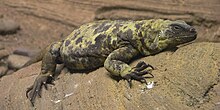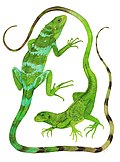San Esteban chuckwalla
| San Esteban chuckwalla[1] | |
|---|---|

| |
| Scientific classification | |
| Domain: | Eukaryota |
| Kingdom: | Animalia |
| Phylum: | Chordata |
| Class: | Reptilia |
| Order: | Squamata |
| Suborder: | Iguania |
| Family: | Iguanidae |
| Genus: | Sauromalus |
| Species: | S. varius
|
| Binomial name | |
| Sauromalus varius Dickerson, 1919
| |
The San Esteban chuckwalla (Sauromalus varius), also known as the piebald chuckwalla or pinto chuckwalla, is a species of chuckwalla belonging to the family Iguanidae endemic to San Esteban Island in the Gulf of California. It is the largest of the five species of chuckwallas, and the most threatened.
Taxonomy and etymology
The
The common name chuckwalla derives from the Shoshone word tcaxxwal or Cahuilla caxwal, transcribed by Spaniards as chacahuala. The Seri people named originally the island for this species: Coftécöl lifa or the Peninsula of the Giant Chuckwalla.[9]
Distribution and habitat
The San Esteban chuckwalla is endemic to San Esteban Island in the Gulf of California.
Behavior and reproduction
Harmless to humans, these large lizards are known to run from potential threats.[10] When disturbed, the chuckwalla wedges itself into a tight rock crevice, gulps air, and inflates its body to entrench itself.[10]
Males are seasonally and conditionally territorial; an abundance of resources tends to create a hierarchy based on size, with one large male dominating the area's smaller males. Chuckwallas use a combination of color and physical displays, namely "push ups", head-hobbing, and gaping of the mouth to communicate and defend their territory.[10]
Chuckwallas are
Mating occurs from April to July, with 5 to 16 eggs laid between June and August. The eggs hatch in late September.[10] San Esteban chuckwallas may live for 25 years or more.
Diet
Chuckwallas prefer dwelling in lava flows and rocky areas with nooks and crannies available for a retreat when threatened. These areas are typically vegetated by
represent a supplementary prey if eaten at all.Description

The San Esteban chuckwalla is the largest species of chuckwalla, reaching 61 cm (24 in) in body length and 76 cm (30 in) overall length, and weighing up to 1.4 kg (3.1 lb).[6] It is considered a textbook example of island gigantism, as it is three to four times the size of its mainland counterparts.[6] The male's skin is gray with tan to yellow patches over its entire body, and its face is gray to black. The female is duller in appearance with fewer patches. The colorations provide almost perfect camouflage against some of their predators.
Human contact
The
The Seri who once inhabited San Esteban Island referred to themselves as Coftécöl Comcáac, "People of the Giant Chuckwalla" and named the island for this species.[9]
The San Esteban chuckwalla is an endangered species due to hunting from the Seri and the introduction of feral animals such as
An
References
- ^ "Sauromalus varius". Integrated Taxonomic Information System. Retrieved 26 September 2008.
- . Retrieved 19 November 2021.
- ^ "Appendices | CITES". cites.org. Retrieved 2022-01-14.
- ISBN 978-0-12-801960-3.
- ^ Liddell, H.G. & Scott, R. (1940). A Greek-English Lexicon. revised and augmented throughout by Sir Henry Stuart Jones. with the assistance of. Roderick McKenzie. Oxford: Clarendon Press.
- ^ )
- )
- ^ Dickerson, M. C. (1919). Diagnoses of twenty-three new species and a new genus of lizards from Lower California. Bulletin of the American Museum of Natural History. 41 (10): 461–477
- ^ ISBN 0-520-21731-4.
- ^ ISBN 0-395-98272-3
- ^ Richard Felger and Mary B. Moser (1985) People of the desert and sea: ethnobotany of the Seri Indians Tucson: University of Arizona Press.


